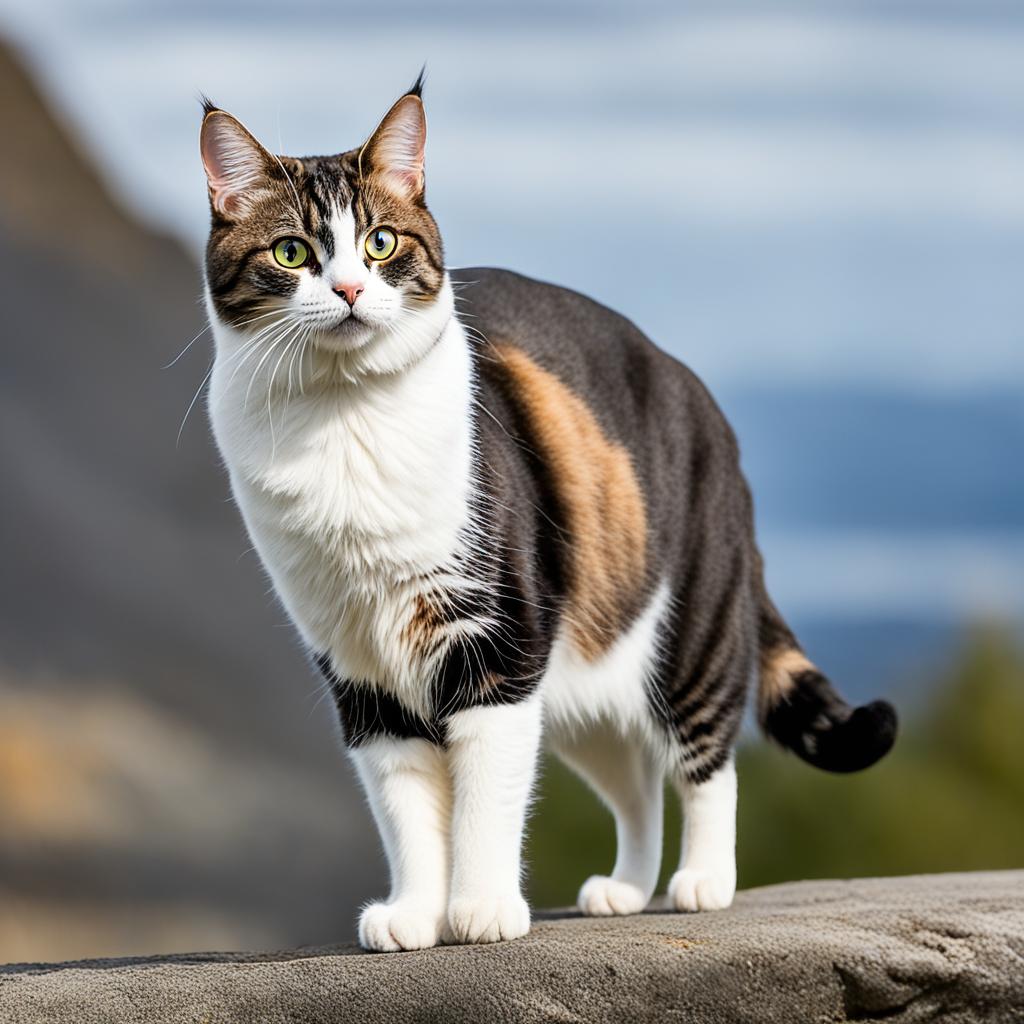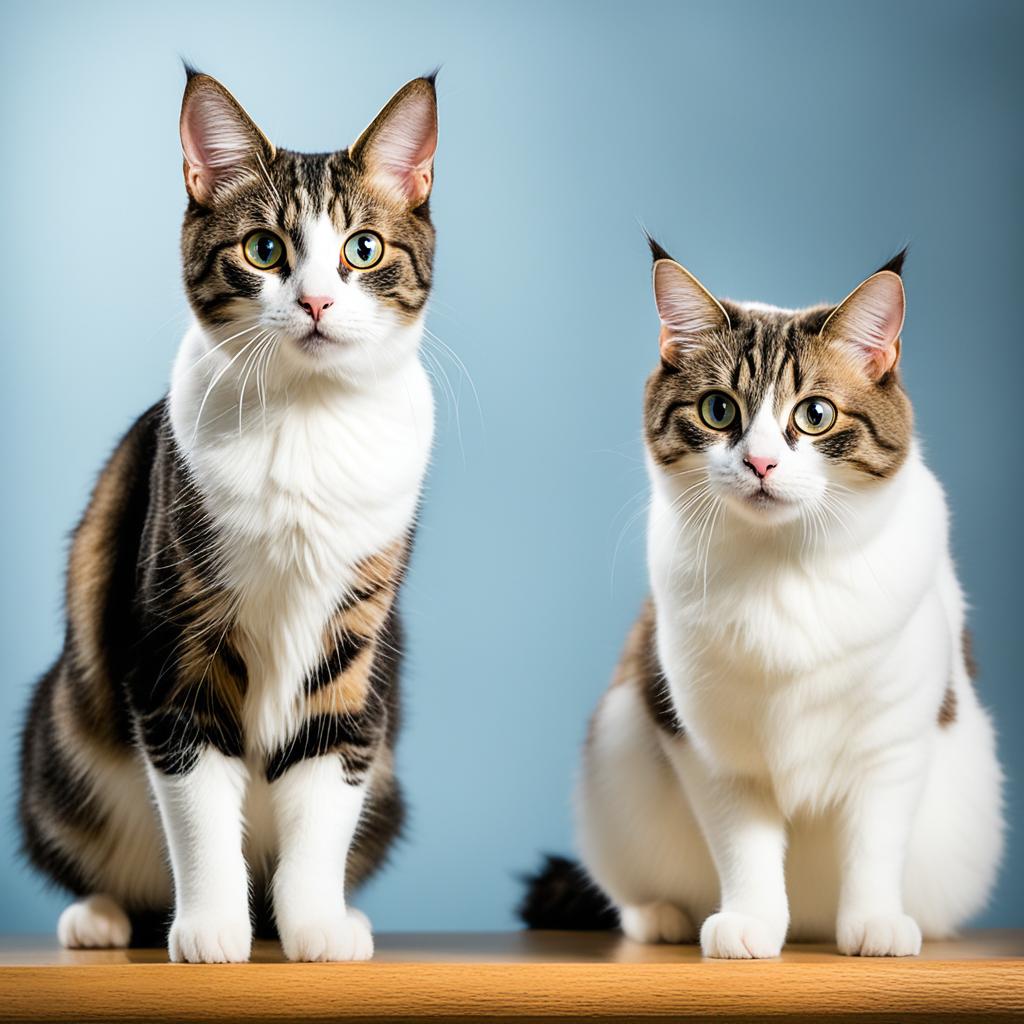Ever wondered why your delightful Manx cat sometimes acts like a feline enigma? Manx cats, with their distinctive looks and unique temperaments, can exhibit a fascinating array of behavior problems. Are we truly prepared to unravel the complexities of these endearing tailless wonders? By diving into their quirks, we can better understand and address Manx cat behavior problems, paving the way for a harmonious home life.
Key Takeaways
- Manx cats are admired for their unique physical and temperamental quirks.
- Understanding these quirks is crucial to mitigating behavioral issues.
- Fostering a positive relationship with your Manx cat can lead to a harmonious living situation.
- Acknowledging and addressing behavioral issues is the first step towards improving your cat’s well-being.
- Studies suggest feline personalities can be classified into distinct traits, similar to human personalities.
Understanding the Manx Cat Personality

Manx cats are celebrated for their distinct personalities, often categorized by the ‘Feline Five’—Neuroticism, Extraversion, Dominance, Impulsiveness, and Agreeableness. These traits were determined through a comprehensive study by researchers who analyzed cat behaviors within their comfortable home settings.
Five Cat Personality Traits
The *Feline Five* highlights key Manx cat personality traits, offering a structured way to understand your feline friend. These traits help in decoding *behavioral patterns* and can be related to their daily activities and interactions.
Insights from “The ‘Feline Five’” Study
The study, spearheaded by feline behaviorists, delved deep into understanding Manx cat behavioral patterns. By observing cats in their natural home environment, researchers unveiled these primary personality traits which can help tailor their care appropriately.
Neuroticism, Extraversion, Dominance, Impulsiveness, and Agreeableness in Manx Cats
Each of these traits plays a unique role in shaping a Manx cat’s personality. For instance, extraverted Manx cats are continually inquisitive, often making their presence felt in household activities. Conversely, more neurotic cats may seek solitude and demonstrate anxious behaviors. Recognizing where your cat fits within these categories not only enhances the living environment but also strengthens the bond you share.
| Personality Trait | Description | Characteristic Behavior |
|---|---|---|
| Neuroticism | Prone to anxiety and stress | Seeks hiding spots, timid |
| Extraversion | Outgoing and curious | Active participation in household |
| Dominance | Exerts control over others | Assertive, may bully other pets |
| Impulsiveness | Acts without thinking | Engages in sudden, random activities |
| Agreeableness | Friendly and accommodating | Seeks human companionship, gentle |
The Neurotic Manx Cat: Anxiety and Insecurity

Neurotic Manx cats often grapple with higher levels of anxiety and insecurity. These endearing yet fragile felines display a host of behaviors that signal their struggle. Notice your Manx retreating to shadowy corners whenever visitors arrive? That’s a telltale sign of anxiety in action.
Coping with Manx cat anxiety doesn’t have to be an uphill battle. Creating safe havens like boxes, tunnels, and secluded nooks will help them feel more secure. Think of these spaces as their personal sanctuaries, providing a refuge from the chaos of the outside world.
Utilize calming aids to help ease their nervousness. Catnip, pheromone diffusers, and even specific calming treats can be immensely beneficial in managing these anxieties. By strategically placing a diffuser or sprinkling some catnip in their favorite hiding spot, you’re taking a proactive step towards ensuring their emotional stability.
Perhaps the wisest approach to coping with Manx cat anxiety is fostering an environment filled with peace and predictability.
Even small gestures, like gentle petting and soothing words, can be effective in calming your furry friend. By acknowledging their insecurities and creating a supportive environment, you’re not just dealing with their anxiety; you’re fortifying a bond built on trust and understanding.
Here’s a snapshot of strategies to help with coping with Manx cat anxiety:
| Strategy | Benefits |
|---|---|
| Safe Haven Creation | Provides a sense of security and minimizes stress |
| Calming Aids | Reduces anxiety levels and promotes relaxation |
| Predictable Routines | Fosters a stable environment, decreasing uncertainty |
| Gentle Interaction | Builds trust and alleviates fear |
Understanding and addressing your Manx cat’s idiosyncrasies will help both you and your feline friend navigate life a bit more smoothly. Happy, contented purrs are just around the corner with these practical tips!
Dealing with Manx Cat Aggression

Dealing with Manx cat aggression can be challenging but manageable with proper techniques.
Aggression in Manx cats cannot merely be brushed off as a quick annoyance. It’s often indicative of deeper issues. Let’s delve into understanding and addressing this behavior effectively.
Identifying Triggers of Aggression
Understanding what triggers aggression in your Manx cat is key. Common triggers may include territorial disputes, fear, or even past traumatic experiences. Observing your cat’s body language and the situations in which aggression occurs can offer valuable insights. Once you identify these triggers, it becomes feasible to take proactive measures to minimize these stressors.
Behavior Modification Techniques
Applying behavior modification techniques can significantly aid in dealing with Manx cat aggression. Start by ensuring that your cat has ample resources, such as separate feeding areas and litter boxes for multiple cats. This helps reduce competition and tension. Utilizing positive reinforcement by rewarding calm behavior can shape a more harmonious disposition.
Training sessions that use toys and treats to divert attention from aggression triggers are highly effective. Additionally, offering vertical spaces like cat trees can help your Manx feel secure and less territorial. Remember that consistency is crucial when implementing these behavior modifications. Incorporating these strategies can lead to improved Manx cat behavior modification.
“Patience and the right approach can transform an aggressive Manx into a more content and stress-free companion.”
| Trigger | Behavior Modification Technique |
|---|---|
| Territorial Disputes | Provide separate resources like feeding areas and litter boxes |
| Fear | Create safe spaces and use calming aids |
| Past Trauma | Employ positive reinforcement and gradual desensitization |
Coping with Manx Cat Anxiety

When it comes to coping with Manx cat anxiety, it’s essential to understand that these felines can be more prone to stress due to their unique temperament and environmental sensitivity. Anxiety in Manx cats can stem from numerous factors, making it crucial for pet owners to identify these causes and provide adequate support.
Common Causes of Anxiety in Manx Cats
Several triggers can increase anxiety levels in Manx cats:
- Environmental changes – Shifts in their surroundings, such as moving to a new home, rearranging furniture, or introducing new pets, can unsettle them.
- Lack of secure spaces – Without ample hiding spots, Manx cats may feel exposed and vulnerable, amplifying anxiety.
- Inconsistent routines – Erratic daily schedules can disrupt their sense of stability, leading to stress.
Providing a Safe Environment
Providing a safe environment for Manx cats entails creating a predictable and secure atmosphere where they can thrive. Ensuring hiding spots, maintaining consistent routines, and incorporating calming aids can significantly enhance their well-being.
Below is a table highlighting practical ways to keep your Manx cat comfortable:
| Strategy | Description |
|---|---|
| Consistent Routines | Establish feeding, playtime, and bedtime schedules to provide stability. |
| Hiding Spots | Create safe spaces using cat tunnels, boxes, or covered beds where they can retreat. |
| Calming Aids | Utilize pheromone diffusers or catnip to soothe and reduce anxiety. |
What Are the Common Behavioral Issues in Manx Cats?

Manx cats, with their intriguing quirks, often exhibit a variety of behavioral issues that you might find challenging yet fascinating. Understanding what are the common behavioral issues in Manx cats is crucial for effective Manx cat behavior management. These issues range from aggression to neuroticism, each stemming from various factors like genetics and upbringing.
| Behavioral Issue | Possible Causes | Management Tips |
|---|---|---|
| Aggression | Territorial disputes, fear | Identify triggers, employ behavior modification |
| Dominance | Genetics, multi-cat households | Establish boundaries, provide resources |
| Impulsiveness | High energy, stress | Offer mental stimulation, structured routines |
| Neuroticism | Insecurity, environmental changes | Use calming aids, create safe spaces |
Effective Manx cat behavior management often necessitates an approach that combines insights from behavioral studies with environmental modifications tailored to their unique needs. Understanding the intricacies behind what are the common behavioral issues in Manx cats enables you to act preemptively, ensuring your feline friend’s well-being and happiness.
Manx Cat Personality Traits: Dominance and Territoriality

When dealing with Manx cat personality traits, it’s imperative to understand their inclination towards dominance and territoriality. These traits can often transform your home into a battleground if not properly managed. Effective Manx cat behavior management ensures a peaceful coexistence, especially in multi-cat households.
Signs of Dominant Behavior
Recognizing signs of dominance in Manx cats is the first step in mitigating conflict. Dominant Manx cats may engage in bullying, territorial spraying, or preventing other pets from accessing resources like food or litter boxes. Observing such behaviors helps in timely intervention.
Managing Multi-Cat Households
Multi-cat households require strategic approaches to prevent territorial disputes. Implementing clear boundaries and providing ample resources for every cat can reduce conflicts. Proactive socialization and routine play sessions can help in establishing a balanced hierarchy, supporting effective Manx cat behavior management.
- Ensure separate feeding stations for each cat.
- Provide multiple litter boxes in different locations.
- Incorporate interactive toys to alleviate boredom-induced aggression.
| Strategies | Benefits |
|---|---|
| Separate Feeding Stations | Reduces food-related territorial disputes. |
| Multiple Litter Boxes | Prevents territorial marking and conflicts. |
| Interactive Toys | Engages all cats, reducing aggression due to boredom. |
Understanding Manx Cat Behavioral Patterns

Ever wondered why your Manx cat exhibits such distinct behavior? Embracing their unique traits can make all the difference in your shared living space. Manx cats are known for their high territorial instincts and supremely strong hunting drives. By understanding Manx cat behavioral patterns, you can better adapt your environment to suit their needs.
First and foremost, the territorial nature of Manx cats is not to be underestimated. These felines often establish their own domains within your home, which they will defend fervently. It’s vital to provide defined spaces to avoid territorial disputes, especially if there are other pets in the house. Utilize vertical spaces such as cat trees and shelves to give them a sense of ownership while also promoting peaceful coexistence.
Beyond territorial instincts, Manx cats also exhibit a commendable hunting drive. This primal urge is why they may frequently engage in pouncing, stalking, and even the odd playful ambush. Incorporating interactive toys and play sessions can help satisfy their hunting instincts, while also enhancing your bond. Consider using toys that mimic prey movements to keep your Manx cat entertained and mentally stimulated.
Adjusting your approach to training and cohabitation becomes simpler when you are focused on understanding Manx cat behavioral patterns. Training efforts that align with their natural behaviors and instincts will be more effective and rewarding. With the right strategies, you can create a safe, engaging, and satisfying environment for your beloved Manx cat.
| Behavioral Trait | Manifestation | Suggested Approach |
|---|---|---|
| Territorial Instinct | Defensive of space | Provide defined, vertical spaces |
| Hunting Drive | Pouncing and stalking | Interactive toys and play sessions |
Manx Cat Behavior Problems: Impulsiveness and Recklessness

Manx cat behavior problems like impulsiveness and recklessness can be quite the challenge. These behaviors often arise as responses to stress or unexpected environmental stimuli. When your adorable Manx suddenly turns into a whirlwind of destruction, it’s time to take decisive action.
To begin addressing these Manx cat behavior problems, it’s essential to implement structured routines. This predictability helps reduce impulsiveness, making your cat feel more secure and less likely to react instinctively. Allowing your furry friend a clear sense of what to expect day-to-day can work wonders.
- Establish consistent feeding times to enhance their sense of stability.
- Provide regular playtimes to channel their energy into healthy activities.
Moreover, don’t underestimate the power of mental stimulation. Puzzle toys or interactive games can divert their impulsive instincts into brain-engaging tasks. This approach not only helps manage Manx cat behavior problems but also keeps your feline mentally sharp and fulfilled.
Another critical component in taming these sudden bouts of recklessness is offering several outlets for physical activity. Scratching posts, climbing trees, and more essential cat furniture can be lifesavers. These additions to your home allow your Manx cat to express their natural behaviors without wreaking havoc.
- Place scratching posts in frequently visited areas.
- Introduce climbing trees to satisfy their adventurous spirit.
When managed with a combination of routine, mental workout, and physical outlets, the most unpredictable Manx cat behavior problems can become much more manageable. Your home can return to its peaceful, albeit playful, state, fostering a harmonious environment for you and your Manx companion.
Conclusion
Living with a Manx cat can be a rewarding experience, if sometimes a bit of a rollercoaster ride. Their intriguing quirks and unique behaviors often require a nuanced approach, but the effort is well worth it. Understanding the “Feline Five” personality traits—neuroticism, extraversion, dominance, impulsiveness, and agreeableness—can provide invaluable insights into your Manx cat’s temperament issues. Awareness of these traits enables you to tailor their environment, making them feel both secure and stimulated.
Addressing Manx cat behavior modification starts with identifying and understanding specific triggers. Whether it’s creating a routine to mitigate anxiety or ensuring adequate resources to reduce aggression, the key is patience and persistence. Behavioral issues like impulsiveness can often be tempered with structured routines and engaging activities, while a safe, stable environment can help alleviate anxiety. The goal is a harmonious coexistence where your furry friend feels understood and respected.
Remember, the road to modifying a Manx cat’s behavior isn’t necessarily easy, but it’s certainly achievable. By leveraging your insights into their unique temperamental traits and applying thoughtful solutions, you can build a strong, affectionate bond. Such a relationship not only enhances your pet’s well-being but also brings an extra dose of joy and warmth into your home. With dedication and love, you and your Manx cat can navigate through any behavioral issues, ensuring a happy and fulfilling life together.




